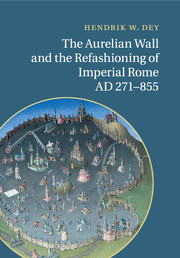Crossref Citations
This Book has been
cited by the following publications. This list is generated based on data provided by Crossref.
Grig, Lucy
2012.
DECONSTRUCTING THE SYMBOLIC CITY: JEROME AS GUIDE TO LATE ANTIQUE ROME.
Papers of the British School at Rome,
Vol. 80,
Issue. ,
p.
125.
Salzman, Michele Renee
2013.
Leo's Liturgical Topography: Contestations for Space in Fifth-Century Rome.
Journal of Roman Studies,
Vol. 103,
Issue. ,
p.
208.
GRIG, LUCY
2013.
Cities in the ‘long’ Late Antiquity, 2000–2012 – a survey essay.
Urban History,
Vol. 40,
Issue. 3,
p.
554.
Salzman, Michele Renee
2014.
The City in the Classical and Post-Classical World.
p.
183.
Christie, Neil
2016.
A Companion to Roman Italy.
p.
133.
Graham, Benjamin
and
Van Dam, Raymond
2016.
Modelling the Supply of Wood Fuel in Ancient Rome.
Late Antique Archaeology,
Vol. 12,
Issue. 1,
p.
148.
Löx, Markus
2017.
Zwischen physischer Absenz und medial-materieller Präsenz: die Kaiser der valentinianisch-theodosianischen Zeit und ihr Verhältnis zur Stadt Rom.
Antiquité Tardive,
Vol. 25,
Issue. ,
p.
149.
Furlan, Guido
2017.
When Absence Means Things Are Going Well: Waste Disposal in Roman Towns and its Impact on the Record as Observed in Aquileia.
European Journal of Archaeology,
Vol. 20,
Issue. 2,
p.
317.
Husár, Martin
2017.
Processions and architecture of Papal Rome in relation to the stay of the Salonica brothers in Rome.
Graeco-Latina Brunensia,
p.
93.
Hillner, Julia
2017.
A woman’s place: imperial women in late antique Rome.
Antiquité Tardive,
Vol. 25,
Issue. ,
p.
75.
Corcoran, Simon
2017.
Maxentius: a Roman emperor in Rome.
Antiquité Tardive,
Vol. 25,
Issue. ,
p.
59.
Coulston, Jon
2018.
A Companion to the City of Rome.
p.
173.
Camerlenghi, Nicola
2018.
St Paul's outside the Walls.
Goodman, Penelope J.
2018.
A Companion to the City of Rome.
p.
71.
Mandich, Matthew J.
2019.
Ancient City, Universal Growth? Exploring Urban Expansion and Economic Development on Rome's Eastern Periphery.
Frontiers in Digital Humanities,
Vol. 6,
Issue. ,
Dey, Hendrik
2019.
POLITICS, PATRONAGE AND THE TRANSMISSION OF CONSTRUCTION TECHNIQUES IN EARLY MEDIEVAL ROME, c. 650–750.
Papers of the British School at Rome,
Vol. 87,
Issue. ,
p.
177.
LaValle Norman, Dawn
2019.
The Aesthetics of Hope in Late Greek Imperial Literature.
Frey, Jon M.
2020.
Postcolonialism, Heritage, and the Built Environment.
p.
27.
Hanson, J. W.
and
Wen, Tzai-Hung
2020.
Using city gates as a means of estimating ancient traffic flows.
PLOS ONE,
Vol. 15,
Issue. 2,
p.
e0229580.
McKitterick, Rosamond
2020.
Rome and the Invention of the Papacy.



